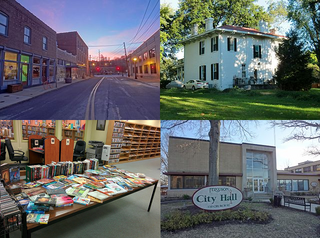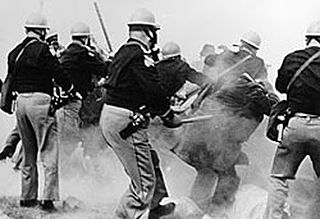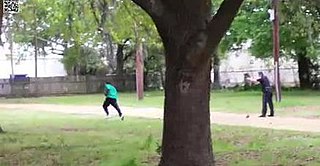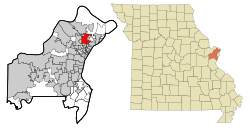
Ferguson is a city in St. Louis County, Missouri, United States. It is part of the Greater St. Louis metropolitan area. Per the 2020 census, the population was 18,527, and predominantly black.

The Miami Police Department (MPD), also known as the City of Miami Police Department, is a full-service municipal law enforcement agency serving Miami, Florida, United States. MPD is the largest municipal police department in Florida. MPD officers are distinguishable from their Miami-Dade Police Department counterparts by their blue uniforms and blue-and-white patrol vehicles.

The Cleveland Division of Police (CDP) is the governmental agency responsible for law enforcement in the city of Cleveland, Ohio.

The Phoenix Police Department is the law enforcement agency responsible for the city of Phoenix, Arizona. As of May 2024, the Phoenix Police Department comprises just over 2,500 officers, some 625 below authorized strength of 3,125 and more than 1,000 support personnel. The department serves a population of more than 1.64 million and patrol almost 516 square miles (1,340 km2) of the fifth largest city in the United States.

The Albuquerque Police Department (APD) is the municipal law enforcement agency of Albuquerque, New Mexico. It is the largest police force in the state, with approximately 1,000 sworn officers in 2022.

Police brutality is the use of excessive or unnecessary force by personnel affiliated with law enforcement duties when dealing with suspects and civilians.
James Matthew Boyd was an American man who was fatally shot by Albuquerque Police Department officers Keith Sandy and Dominique Perez in the foothills of the Sandia Mountains in Albuquerque, New Mexico on the evening of March 16, 2014. A resident of a nearby subdivision called police at 3:28 p.m. to report that a man had been camping on the mountain behind his house for the previous month, a violation of local regulations. Two Open Space officers were the first to respond. They approached Boyd as he lay under a sheet of plastic; Boyd, mentally ill with a diagnosis of schizo-affective disorder, became irate, wanting to know why the "raid" was occurring. When an officer tried to pat him down, he produced two pocket knives, threatening the officers with them. The caller watched the confrontation from his second-story window and later testified that Boyd threatened the officers.

United States v. City of Portland was a lawsuit filed by the United States Department of Justice against the City of Portland, Oregon on December 17, 2012, alleging a pattern or practice of unconstitutional use of force by the Portland Police Bureau against individuals with actual or perceived mental illness.

On August 9, 2014, 18-year-old Michael Brown was shot and killed by police officer Darren Wilson in Ferguson, Missouri, a suburb of St. Louis.

The Ferguson unrest was a series of protests and riots which began in Ferguson, Missouri on August 10, 2014, the day after the fatal shooting of Michael Brown by FPD officer Darren Wilson. The unrest sparked a vigorous debate in the United States about the relationship between law enforcement officers and Black Americans, the militarization of police, and the use-of-force law in Missouri and nationwide. Continuing activism expanded the issues by including modern-day debtors prisons, for-profit policing, and school segregation.
Hands Up United is a social justice activist organization based in Ferguson, Missouri, formed after the fatal shooting of Michael Brown by a police officer. The organization seeks justice in the Michael Brown case and prevention of future incidents nationwide as well as more accountability for police and improving transparency in police and justice departments across the United States. It also offers web technology training workshops to address issues related to the digital divide and economic equality.

"Hands up, don't shoot", sometimes shortened to "hands up", is a slogan and gesture that originated after the August 9, 2014, police shooting of Michael Brown in Ferguson, Missouri, and then adopted at protests against police brutality elsewhere in the United States. The slogan implies one has their hands in the air, a common sign of submission, and is therefore not a threat to an approaching police officer. Witness reports from the Brown shooting are conflicted as to what Brown was doing with his hands when he was shot. One witness claimed Brown had his hands in the air before being killed, which was the basis for the slogan.

Ezell Ford, a 25-year-old African-American man, died from multiple gunshot wounds after being shot by Los Angeles Police Department (LAPD) officers in Florence, Los Angeles, California on August 11, 2014. In the weeks and months that followed, Ford's shooting triggered multiple demonstrations and a lawsuit by Ford's family claiming $75 million in damages.
In the wake of civil unrest and protests in Ferguson, Missouri, Professor Marcia Chatelain of Georgetown University created the #FergusonSyllabus Twitter campaign. Ferguson syllabus provides a space for educators to discuss integrating the events that happened in Ferguson into classrooms.
Racial biases are a form of implicit bias, which refers to the attitudes or stereotypes that affect an individual's understanding, actions, and decisions in an unconscious manner. These biases, which encompass unfavorable assessments, are often activated involuntarily and without the awareness or intentional control of the individual. Residing deep in the subconscious, these biases are different from known biases that individuals may choose to conceal for the purposes of social and/or political correctness. Police officers have implicit bias, regardless of their ethnicity. Racial bias in criminal news reporting in the United States is a manifestation of this bias.
The shooting of Antonio Zambrano-Montes occurred on February 10, 2015, in Pasco, Washington, United States. Zambrano, a 35-year-old man originally from Michoacán, Mexico, was shot and killed by three police officers after allegedly throwing rocks at cars and police officers. His hands were in the air when the police fired the shots. Police officers said one of the rocks was as large as a softball. A toxicology report conducted by police found Zambrano's blood tested positive for methamphetamine.

Police reform in the United States is an ongoing political movement that seeks to reform systems of law enforcement throughout the United States. Many goals of the police reform movement center on police accountability. Specific goals may include: lowering the criminal intent standard, limiting or abolishing qualified immunity for law enforcement officers, sensitivity training, conflict prevention and mediation training, updating legal frameworks, and granting administrative subpoena power to the U.S. Department of Justice for "pattern or practice" investigations into police misconduct and police brutality.

On April 4, 2015, Walter Scott, a 50-year-old black man, was fatally shot by Michael Slager, a local police officer in North Charleston, South Carolina, United States. Slager had stopped Scott for a non-functioning brake light. Slager was charged with murder after a video surfaced showing him shooting Scott from behind while Scott was fleeing, which contradicted Slager's report of the incident. The racial difference led many to believe that the shooting was racially motivated, generating a widespread controversy.
The Ferguson effect is an increase in violent crime rates in a community caused by reduced proactive policing due to the community's distrust and hostility towards police. The Ferguson effect was first proposed after police saw an increase in violence following the 2014 shooting of Michael Brown in Ferguson, Missouri. The term was coined by Doyle Sam Dotson III, the chief of the St. Louis police, to account for an increased murder rate in some U.S. cities following the Ferguson unrest. Whether the Ferguson effect really exists is subject of discussions with many published studies reporting contradicting findings concerning whether there is a change in crime rates, number of 911 calls, homicides, and proactive policing. Furthermore, the effect and influence of the portrayal of police brutality in the media is also contested.

The murder of Laquan McDonald took place on October 20, 2014, in Chicago, Illinois. McDonald was a 17-year-old who was fatally shot by a Chicago Police Officer, Jason Van Dyke. Police had initially reported that McDonald was behaving erratically while walking down the street, refusing to put down a knife, and that he had lunged at officers. Preliminary internal police reports described the incident similarly, leading to the shooting being judged as justifiable, and Van Dyke not being charged at the time. This was later disproved after a video of the encounter was released, showing that McDonald was walking away.























